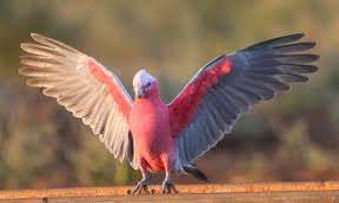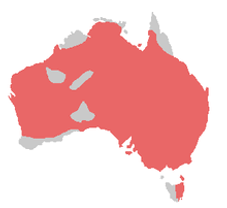Galah(Eolophus roseicapilla)
They are also known as the pink and grey cockatoo. Galahs are about 35 cm long and weigh 270–350 g. They have a pale silver to mid-grey back, a pale grey rump, a pink face and chest, and a light pink mobile crest. They have a bone-coloured beak, and the bare skin of the eye rings is carunculated. They have grey legs.

The sexes appear similar; however, generally adult birds differ in the colour of the irises; the male has very dark brown (almost black) irises and the female has mid-brown or red irises. The colours of the juveniles are duller than the adults. Juveniles have greyish chests, crowns, and crests, and they have brown irises and whitish bare eye rings, which are not carunculated. Three subspecies are usually recognised. Slight variation exists in the colours of the plumage and in the extent of the carunculation of the eye rings among the three subspecies. The south-eastern form is clearly distinct from the paler-bodied Western Australian nominate subspecies, although the extent and nature of the central hybrid zone remains undefined. Most pet birds outside Australia are the south-eastern form. The third form, found right across the northern part of the continent, tends to be a little smaller and is distinguished by differences in the shape and colour of the crest, although its status as a valid subspecies is uncertain.
Habitat
The Galah lives in most parts of Australia, including some offshore islands, and it has been introduced to Tasmania. It occupies a range of habitats, including woodland, grassland and shrubland. It also adapts well in urban areas, pastures, parks, and agricultural land, though it avoids dense forest. They are common in some metropolitan areas, and common to abundant in open habitats that offer at least some scattered trees for shelter.

Diet
Galahs eat seeds, grains, fruits, nuts, berries, grasses, roots, leaf buds, green shoots, and insects and their larvae.
Breeding
Galahs are monogamous birds and pairs mate for life. Males display to females by strutting towards them, with bobbing and waving of the head and raising of their crest, giving soft calls and also clicking their bill. The breeding season in the north is from February to July, and in the south from July to December. Galahs nest in tree hollows or in cavities in cliffs. Often many pairs nest close to each other. Females lay between 2 and 5 white eggs, and incubation lasts around 4 weeks, shared by the parents. The chicks are fed at the nest by their parents for 5 to 6 weeks. They then leave the nest to gather in a “crèche tree”, along with other young birds. For 2 to 3 more weeks they are still fed by their parents. Then the parents fly away to molt. The young are independent by between 6 and 8 weeks old. Young birds join large nomadic flocks with non-breeding birds until they are 2 to 3 years old. They are ready to breed when they are four years old.
Population
According to the IUCN Red List, they are classed as Least Concern(LC). The global population size has not been quantified, but the species is described as common. The population is suspected to be increasing as ongoing habitat degradation is creating new areas of suitable habitat.
Threats
The Galah is an abundant and widespread species, and it is not currently considered at risk of extinction. Galahs are, however, considered a pest throughout most parts of Australia and can be trapped, shot or poisoned in an effort to reduce losses to local agriculture, especially in grain-producing districts.
Conservation
There are currently no conservation actions for this species as it is very common and widespread.